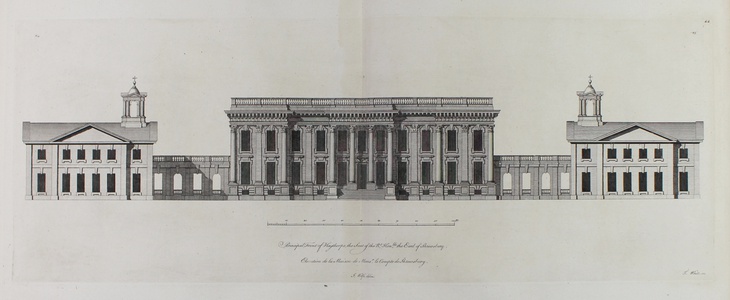| Method | Copper engraving |
| Artist | Thomas White after John Woolfe |
| Published | J. Woolfe delin. T. White sc. [London, 1765-1771] |
| Dimensions | Image 190 x 660 mm, Plate 250 x 680 mm, 575 x 715 mm |
| Notes |
Titled in English and French. A finely engraved architectural view of the north front of Heythrop Park, Oxfordshire, from the Woolfe and Gandon volumes of Vitruvius Britannicus, or, The British Architect. The House was designed by Thomas Archer for Charles Talbot, 1st Duke of Shrewsbury. The Duke had travelled in Italy between 1700 and 1705 on an extensive Grand Tour, so the house was designed in the baroque style, and inspired by a collection of prints by Borromini and Bernini that the Duke had acquired from the publisher and designer Domenico de' Rossi. Vitruvius Britannicus or, the British Architect. Containing the Plans, Elevations, and Sections of the most Regular Buildings both Publick & Private in Great Britain was the first architectural work to emerge from England since John Shute's The First and Chief Groundes of Architecture, which was first printed in 1563. Often regarded as a catalogue of designs, Vitruvius Britannicus contained a number of plans, elevations, and sections of buildings in Great Britain by the most prominent architects of the day, including Inigo Jones and Sir Christopher Wren. The text as well as a great many of the designs were the work of the Scottish architect Colen Campbell, with the first three volumes being published between 1715 and 1725. The success of Vitruvius Britannicus was instrumental in popularising neo-Palladian Architecture in Great Britain and America during the eighteenth century, and was one of the driving forces behind the development of Georgian architecture. The book inspired two significant imitators, both of whom borrowed the title for their own publications. The first, in 1739, was published by Badeslade and Rocque, but featured mostly topographical views. Between 1765 and 1771, the architects Woolfe and Gandon issued their own two volume set as Vitruvius Britannicus Volumes IV and V. In style, their publication was a much closer fit to the Campbell originals, and featured some of the finest examples of architecture to have appeared in the 40 years between the two books. Thomas White (c.1740-1775) was a British engraver and draughtsman, who worked mostly on architectural plates. John Woolfe was an Irish draughtsman active in the latter half of the eighteenth-century. From the 1750s onwards, Woolfe was employed in the Office of Works. He was the joint author with James Gandon of volumes 4 and 5 of Vitruvius Britannicus. His son, of the same name, worked for the Office of Works between 1787 and 1806. Colen Campbell (1676-1729) was a Scottish architect and architectural writer, credited as a founder of the Georgian style. He is best known as the author of Vitruvius Britannicus. Domenico de' Rossi (1659 – 1730) was an Italian publisher, engraver, bookseller, and antiquarian. The scion of a large and prolific family of printers, Domenico inherited the Rossi printshop from his father, Giovanni Giacomo de' Rossi. The printworks was established near the church of Santa Maria della Pace in 1633 by Guiseppe de'Rossi, who specialised in producing engravings for designers. Under Giovanni Giacomo and Domenico, the workshop reached its zenith, with father and son working on engravings on many diverse subjects, but with a speciality in publishing works of antiquarian interest. Domenico's friendship and collaboration with the engraver Bartoli and the antiquarian Bellori proved fruitful, and in the period between the early 1690s and Domenico's death in 1730, the group published numerous works on Roman architecture, sculpture, history, portraiture, ceramics, oil lamps, and funerary iconography. In Domenico's later life, his connections with the influential Maffei family secured the Rossi imprint Papal privilege. Following Domenico's death, the Rossi printshop became the Calcographia Camerale, then the Regia Calcographia, and finally the current Calcographia Nazionale. Condition: Central vertical fold, as issued. Minor time toning to sheet, particularly to central fold. Minor creasing to left and right edges of sheet. |
| Framing | unmounted |
| Price | £175.00 |
| Stock ID | 50910 |

